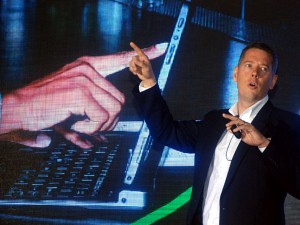New Intel Core processors bring more power, capabilities to digital devices

Leighton Phillips, Director and Product Marketing Pricing Intel Asia Pacific, delivered the keynote address highlighting the features of the new 4th Generation Intel Core processor. (Photo by Strategic Edge Inc)
MANILA, Philippines – In the next generation of computer devices, the distinction between desktops, laptops, and smartphones and tablet computers may be even more blurry as they are now.
This reality now seems imminent with the unveiling recently in the Philippines of new Core processors developed by international computer technology company Intel Corp. These processors are expected to pave the way for computers that have the power and speed of desktop computers, the mobility of laptops, and the ease-of-use of smartphones and tablets.
“It’s not clear anymore what’s a computer, what’s a phone, what’s a tablet, all these three are merging, they’re coming together and the lines are being blurred between consumption devices and productivity devices,” Leighton Philipps, Director of Product Marketing for Intel Asia Pacific, said during the launch.
“The usage model is no longer constrained to the desk, the capability we have on the desktop will be taken beyond the desk, the device will actually change [for] the user rather than the user having to change to the device,” he said.
Improved battery life
The latest family of Core processors boasts a 50 percent improvement in battery life from the previous generation through reduced power consumption. This was the biggest improvement in the history of Intel, Philipps said.
Some computers that will be powered by these new processors can have up to nine hours of active battery life use and can last 10 to 13 days on standby.
This is through the scalable architecture of the processor which allows Intel to create several processor “families” that range from a power consumption of 6 watts up to 95 watts, Philipps said.
“What this means is that there is not a computing form factor on the planet that cannot be delivered using this microarchitecture,” he said.
“The fourth generation core is the first time that we have been able to compress the thermal and the wattage down so much that we can now move that processor from under the keyboard to behind the screen,” Philipps added. “We can bring the best of the PC and the best of the tablet into one device.”
Among the computer devices that the fourth generation core will power are ‘‘2-in-1s’’ or laptops that can convert into a tablet by separating the screen from the rest of the body or by folding the screen back.
Philipps said that the spread of touch-enabled devices was driving the change in computers. By the end of the year, 50 percent of devices produced that are not tablets or smartphones will already be touch-enabled.
With the new fourth generation core processors, “100 percent of every Ultrabook built will be touch enabled,” Philipps said.
No compromise
Traditionally, Philipps said there was a hard time balancing between the “trifecta” of form factor, battery life, and performance of computers.
“Historically it was hard to have all three; if you wanted a lot of performance some of your battery life went down,” Philipps said.
“With the fourth generation … any design of product with this microarchitecture does not have to make a compromise, it has the form factor, performance graphics, battery life,” he said.
This was achieved because of the fourth generation’s system-on-chip design that integrates the video processor into the processor eliminating the need for a separate video card and speeding up the encoding process in creating videos.
The latest generation processors will also allow for features such as voice control, movement and gesture recognition, as well as facial recognition that can remember the user’s face even as he grows older, Philipps said.
Industrial application
The new processors will also find use in various industrial sectors such as the health and retail sectors, Intel said.
Computer manufacturers will be able to “design thinner, lighter, and sleeker medical devices such as portable ultrasound equipment and patient monitors or wearable PC’s for fire and police department employees,” Intel said in a statement released during the launch.
“In industrial market segments, this also enables support for smaller form factors in computer intensive applications while helping equipment manufacturers address new environments and save factory floor space,” it said.
Philipps said that removing the keyboard and making these industrial machines fully touch-enabled could make their operation “more natural with touch and even with voice and gesture.”